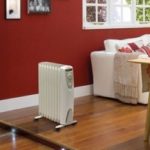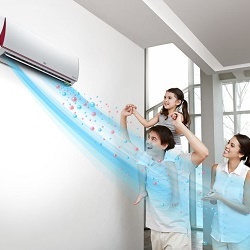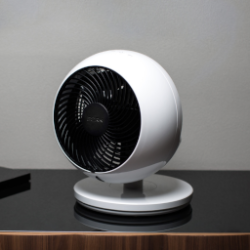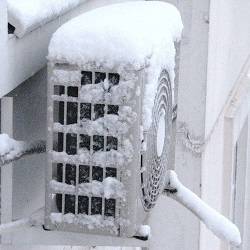What type of heater to choose for a house or apartment
Buying a heating device for their home, many are faced with a huge range of them. How among the many presented devices to choose the most suitable? What types of heaters for the house are the most economical, and for what purposes are they suitable?
Content
Classification
Consider the main types of heating devices, their advantages, disadvantages and methods of use. In total, there are four types of household heaters with different principles of operation:
- Oil radiators.
- Convectors (electric, water, gas), which work on the principle of convection, moving the heated air upward and sucking cold air from below for subsequent heating.
- Infrared heatersheating the long-wave beams (according to the principle of the sun in nature) walls, floors and various things in the apartment.
- Fan heaterscreating warm directional airflow.
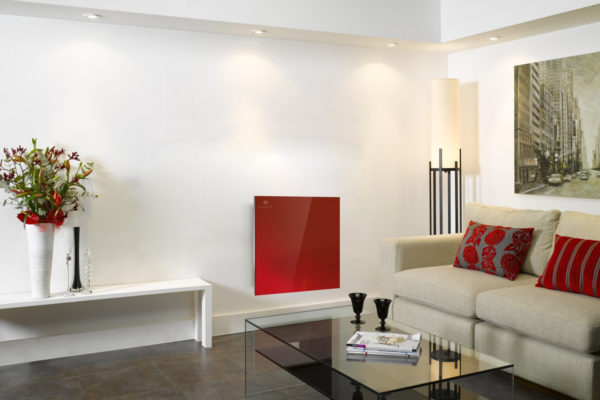
Heater in the interior of the apartment
Oil radiators
Oil heaters that are quite mobile batteries filled inside with mineral oil are very good for heating a private house or apartment. The surface of the battery is heated. by heating the oil, by means of heating elements (1 or 2 heating elements are connected). Such radiators consist of several sections, and the more of them, the more heat such a battery gives out.
When choosing a home oil heater, pay attention to its power. The calculation of the required power is as follows: 1 kW can heat a room at 10 m2 (with a ceiling height of 3 m).
Also, fan heaters are sometimes built into the oil heaters, which greatly reduces the heating time of the room. The advantages of oil heaters include:
- The presence of a thermostat, which can adjust the power of the device (if the heater is two, then the thermostat knobs should also be two).
- Complete with a timer (in most modern models) to set the time on or off the installation.
- Relatively low cost.
- Mobility (they can be freely moved around the room or to other rooms).
- The ability to work for some time without the consumption of electricity (due to the already heated oil, which cools down very slowly), which can provide significant savings.
The disadvantages of this type of household heaters include:
- Long heating (which is compensated by slow cooling).
- Considerable dimensions and weight of the device.
- Strong heating of the casing surface (however, most models are equipped with a special protective casing for safety reasons).
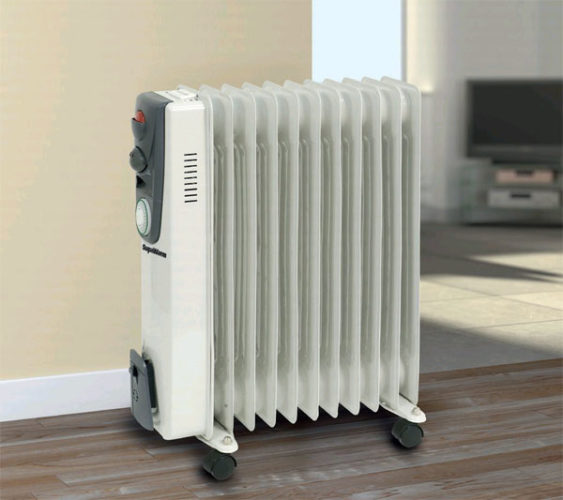
Convection heaters
The operation of such devices is based on the principle of convection. Cold air enters the lower grate of the convector and, being well heated by the shade, comes out through the upper grate of the appliance and rises to the ceiling. Then, heating the walls and ceiling and thus cooling, the air again descends and passes through the lower grille for subsequent heating (for more details see the articlehow does electric convector work).
Convector installations are divided by different signs. For example, they can be classified by type of installation:
- Outdooreasily moved in any direction.
- Wall mounted (vertical, horizontal), differing in small thickness and attractive design. They can be mounted under the window, like batteries.
- Ceiling. They can be mounted like a wall.
- Embedded. They are often mounted simply in the floor to improve the uniform heating of the entire room. To do this, you need to lay in the floor niches for laying pipelines that supply hot coolant. From above, such convectors cover with a beautiful grill for the penetration of warm air.
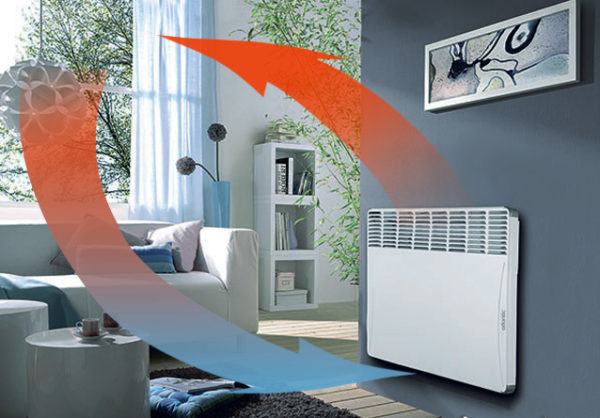
They are also shared. by type of heating:
- Water. Sometimes require special installation of the boiler and piping.
- Electric. The simplest and fastest devices in heating, easy to install, do not require additional installations.
- Gas. In residential buildings rarely used.
And even by type of circulation:
- Natural, based on simple convection.
- Forced, with built-in fan for better and faster warm-up.
The advantages of convector heaters include:
- Noiselessness in work.
- The temperature of the body is usually not higher than 60-65 degrees, which makes them fairly safe.
- Built thermostat To adjust the automatic self-off and on.
- Built-in emergency overheating protection.
They are convenient to use. The most convenient of them are floor convectors. They are quite mobile, they can be freely moved to the desired zone. The main thing is to have enough length of the electric cord, since they all work from the network.
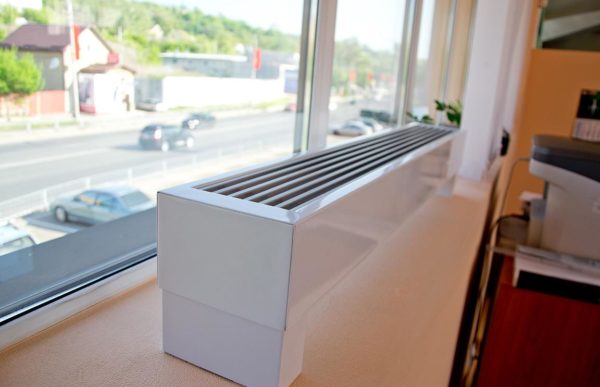
They are sometimes difficult to install. Electric, water and gas convectors are often an alternative to a central heating system. For them, as a rule, provided special installation (especially for water and gas), implying installation of the boiler, wiring pipes and ventilation ducts.
Convector-type electric heaters are difficult to heat large rooms.
Infrared heating systems
These types of electric heaters contain special lamps inside the housing:
- Halogencontaining a tube of thread filled with an inert gas.
- Carbon fiberhaving carbon fiber filaments.
- Quartz with tungsten filaments.
These lamps are able to emit long-wave infrared rays that are invisible to the human eye.From them, as well as from the sun (by analogy with nature), heat up all the objects in the room (floors, walls, furniture), and then the air. According to their performance, these heaters are:
- Ceiling.
- Wall mounted.
- Outdoor.
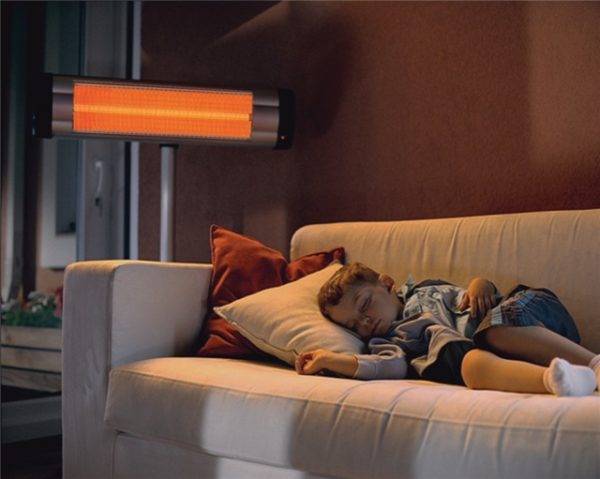
They can be installed not only in living rooms, but also, if necessary, on balconies, terraces, greenhouses, etc.
Advantages of infrared heaters:
- Noiselessness in work.
- Economical power consumption.
- The ability to heat without raising dust in the air.
- Devices do not dry out the air and do not burn oxygen.
- Uniform warming of the air throughout the room (for more details on the work scheme, see the articleprinciple of operation of the heater with infrared radiation).
- When you turn on the device, the room starts to warm up instantly.
The disadvantages of these devices can be attributed perhaps that they are quite high cost.
Fan heaters
The most affordable and easy to use are heat fans, which are usually desktop or outdoor. With the passage of air through the heating elements of the device is provided fast warm-up any room. The heating elements in the heater are performed in the form:
- Electric open spiral with temperatures up to 800 degrees.
- An electric tube-shaped heater with a temperature in excess of 200 degrees.
- Ceramic tiles with a temperature of up to 200 degrees.
Heat fans with ceramic heating elements provide more clean air supply, without emission of products of combustion. Devices are popular because of their low cost and ease of carrying. They almost instantly heat the room to the desired temperature.
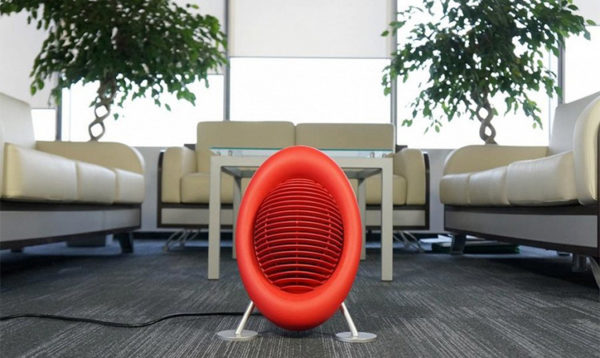
Fan heaters are economical: 1 kW of device power can warm a room up to 20-25 m2.
In addition to these characteristics, their advantages include the presence of thermostatwhich instantly turns off the device when overheating.
The disadvantages of heat fans include their noise and the ability to raise dust in the room.
There is also a type of heater, such as blowers or heat guns. In the system of such heat cannons there are incandescent spirals and a powerful fan. Blowers are very effective in cold rooms, such as garages.
Conclusion
Among the huge number of different types of heaters for an apartment and a house you can always choose a device,most satisfying to all requirements, if you know all its technical characteristics, pros and cons. He will not only warm the room, but also give him comfort, create the necessary microclimate in the room. The main thing is to match the price with quality, power with a heated area, and ease of use with ease of care for the device.

/rating_off.png)






